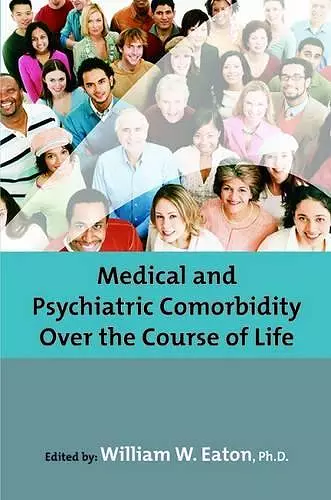Medical and Psychiatric Comorbidity Over the Course of Life
American Psychopathological Association author William W Eaton editor
Format:Hardback
Publisher:American Psychiatric Association Publishing
Published:22nd Nov '05
Currently unavailable, and unfortunately no date known when it will be back

Compiled from presentations given at the 2004 American Psychopathological Association (APPA) annual meeting, Medical and Psychiatric Comorbidity Over the Course of Life reviews the comorbidity of mental and chronic physical syndromes in an epidemiological and life course context, offering fresh insights and identifying crucial clues—gleaned from the overlapping areas or areas of mutual pathogenesis linking disparate realms of knowledge—to the etiology and nosological distinctiveness of both physical and mental disorders.
Once relatively ignored, the study of lifetime comorbidity has the potential to suggest etiological clues and to advance our ability to prevent secondary disorders by increasing our knowledge about the course and pathology of the primary disease.
The etiologically relevant period, beginning with the earliest causal action and ending with diagnosis, helps us understand this potential and thus is vital to the study of comorbidity. Divided into five main sections (epidemiology, risk factors, mood disorders, emotions and health, and schizophrenia), Medical and Psychiatric Comorbidity Over the Course of Life discusses critical aspects of the life course characteristics of the etiologically relevant period:
• It can be long, e.g., temperament, a relatively enduring emotional predisposition, may situate an individual more or less permanently at high risk, culminating in irreversibility only after decades of induction. The action of identical genes produces different disorders that may occur at different stages of life, such as the comorbidity of panic disorder and cystitis.
• It may involve critical stages, i.e., relatively narrow periods during development, such as fetal growth and puberty, to which the action of a given cause is limited. Critical periods of varying durations may exist throughout the course of life.
• It may have a cumulative quality to it, in which years or even decades of accumulation are required to reach the point of irreversibility, e.g., the years-long burden of lower class life, or of increased allostatic burden, for the causal nexus to reach sufficiency.
• It may involve multiple causes, representing different disciplines and different spheres of action spread throughout the life course.
Medical and Psychiatric Comorbidity Over the Course of Life will prove invaluable for practitioners in general and consultation-liaison psychiatry, family practice and internal medicine, and psychosomatics, behavioral medicine, and health psychology.
[Medical and Psychiatric Comorbidity Over the Course of Life] serves as an excellent reference of how epidemiological methods work. The methods provide a unique way to study psychological disorders, in their natural context within a population. The book's conclusion, the most compelling of many studies, is that comorbid conditions provide a rich context of relationships between the mind and body. . .. For many psychologists, the book provides illustrative examples of studying mental illness in ways that may be unfamiliar.
* PsycCRITIQUES *Overall the book succeeds in its mission to acquaint the reader, from a variety of perspectives, with the advantages and limitations of life-course epidemiology as a powerful tool to discover the nature of the relationships between medical and psychiatric disorders.
* JAMA *This is an important contribution to the study of medical and psychiatric comorbidity starting from an important primer on life course epidemiology. The wide variety of psychiatric and medical topics serves to demonstrate an expanding and exciting area of academic inquiry.
* Doody's Book Review Service *The strength of this [Medical and Psychiatric Comorbidity Over the Course of Life] resides in its readable accounts of the concepts underpinning complex lines of research, examples being investigation of links between foetal experience and the pathogenesis of schizophrenia, and between depression and bone loss and osteoporosis. Risk factors, emotions and health, and other aspects of mood disorders and schizophrenia are also covered. As might be expected, the contributions introduce many 'new' concepts – allostasis, translational and reverse translational research, postmodern illness, and the fundamental social causes hypothesis, to cite a few. I found the discussion of putative autoimmune and metabolic mediation of physical comorbidities of schizophrenia of particular interest.For specialists interested primarily in borderline personality disorder and in psychoanalytic methods, the book is reassuring and informative
* British Journal of Psychiatry *This well-edited collection of studies and reviews examines causal and clinical overlapping of psychiatric and general medical disorders. The material selected isthoughtful and concise.
* Journal of Clinical PsychiatISBN: 9781585622313
Dimensions: 229mm x 152mm x 25mm
Weight: 685g
320 pages